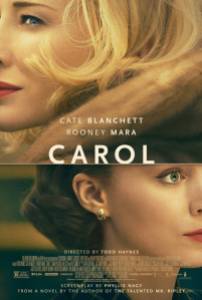 Rooney Mara as Therese Belivet in Todd Haynes’s “Carol” has perky, rosy makeup, frayed bangs beneath a plain black hair band, cute plaid outfits and a checkered fall hat. She looks like one of the toy dolls in the department store where she works. Enter Cate Blanchett as Carol Aird, who wears a movie star aura with a giant coat of golden fur, a stylish red French cap and later in the car an elegant green shawl to keep her looking perfect.
Rooney Mara as Therese Belivet in Todd Haynes’s “Carol” has perky, rosy makeup, frayed bangs beneath a plain black hair band, cute plaid outfits and a checkered fall hat. She looks like one of the toy dolls in the department store where she works. Enter Cate Blanchett as Carol Aird, who wears a movie star aura with a giant coat of golden fur, a stylish red French cap and later in the car an elegant green shawl to keep her looking perfect.
In fact, both characters are particularly magnetic, and the attraction they form in “Carol” is mutual. “Carol” is a coming-of-age story for the young Therese, but it’s a movie about two people entering into separate worlds and learning to feel at home. Haynes’s film is lush, poetic, and ravishing, a stellar romance in which the unsaid words and thoughts seep into the movie’s background and color everything.
After all, “Carol” is all about backgrounds. Haynes admires the patterned sewer grates in his opening crane shot and the beads of rain on a taxicab that give the whole film an elegiac tone. There are soothing green backdrops viewed through windows and individual stills that have painterly beauty.
Haynes adorns these details with care because the many words and themes of Carol and Therere’s courtship go unsaid. Set in 1952, when being gay was considered a psychological illness, Haynes avoids the thorny jargon and the explicitness of their affair. Carol and Therese are desperate to feel close to each other, and Carol begs Therese to “Ask me, please!” They want to speak their emotions and not have them be taboo.
Unlike the racial tension of Haynes’s other ‘50s period piece “Far From Heaven”, “Carol” is not a social issue film. It’s a deeply personal love story; Carol’s desires are tearing her apart from her husband (Kyle Chandler) and her young daughter, and Therese’s uncertainty about her sexuality complicates her relationship with a potential fiancée (Jake Lacy).
Mara and Blanchett have impeccable chemistry. When they first have lunch together, Therese again echoes her innocence, with Mara ever so slightly propping herself up in her seat as though she’s never had a cigarette before. It’s a wonderful little touch, and she as an actress maintains the film’s mystique by never appearing too indecisive or too waifish. Mara’s an accomplished actress, but here she channels a young Audrey Hepburn’s natural graces.
Blanchett meanwhile channels just about all the rest of Old Hollywood, and slowly she reveals herself to be a flustered, hurt woman without ever losing her poise or leaving her bubble. It’s not unlike the work she did that won her an Oscar in “Blue Jasmine”, but here she’s likeable and ultimately as vulnerable as her innocent young lover.
Phyllis Nagy’s debut script from a novel by Patricia Highsmith (“The Talented Mr. Ripley”) is poetic, profound and beautiful. The cinematography by longtime Haynes collaborator Edward Lachman is dreamy. And the aforementioned costumes by three-time Oscar winner Sandy Powell are impeccable.
But above all the technical brilliance, heed a piece of advice given to Therese: “I have a friend who told me I should be more interested in humans.” “Carol” delves deep into the world of these two human beings and finds a home.
4 stars
